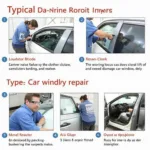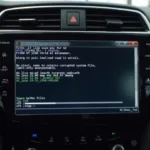Dealing with a stubborn car window that refuses to budge? Electric power windows are a godsend – until they stop working. While it might seem daunting, troubleshooting and even repairing your car’s electric windows might be easier than you think. This guide dives into the common culprits behind power window failures and provides a step-by-step approach to get those windows moving smoothly again.
Understanding the Mechanics of Electric Car Windows
Before you grab your toolbox, it’s helpful to understand the basic components of your car’s power window system:
- Window Regulator: This mechanism moves the window glass up and down. There are two main types – cable driven and scissor-style.
- Window Motor: This provides the power to move the regulator.
- Switches: These control the flow of electricity to the motor, dictating the window’s direction.
- Wiring and Fuses: These components ensure a consistent flow of power to the entire system.
Common Causes of Electric Window Failure
A variety of issues can cause your electric windows to malfunction. Here are some of the most frequent culprits:
- Blown Fuse: This is often the easiest fix. Check your car’s fuse box (usually located under the dashboard or hood) for a blown fuse related to the power windows.
- Faulty Window Switch: Over time, the contacts within the switch can wear out or become clogged with dirt. This can prevent the switch from sending a signal to the motor.
- Bad Window Motor: If you hear a clicking sound but the window doesn’t move, the motor itself may be faulty.
- Worn Window Regulator: Wear and tear on the cables or gears of the regulator can prevent it from moving the window properly.
- Wiring Problems: Damaged or corroded wiring can interrupt the flow of electricity to the window motor or switch.
Troubleshooting Your Car’s Power Windows
Now that you know the usual suspects, let’s diagnose the problem:
- Check the Fuse: Locate your car’s fuse box and consult the owner’s manual to identify the fuse associated with your power windows. Look for a broken wire or a melted metal strip within the fuse.
- Test the Switch: With the car on, try operating the window switch. Listen for any clicking sounds coming from the door panel. If you don’t hear anything or the click is faint, the switch may be the issue.
- Inspect the Motor: If you have a multimeter, you can test the motor for power. Alternatively, you can carefully remove the door panel and try applying direct power to the motor to see if it runs.
- Examine the Regulator: If the motor runs but the window doesn’t move, or moves erratically, the window regulator is likely the culprit.
How to Repair Electric Power Windows: A Step-by-Step Guide
Once you’ve identified the source of the problem, it’s time to roll up your sleeves and attempt a repair.
Replacing a Blown Fuse
- Locate the correct fuse using your owner’s manual.
- Remove the blown fuse using the fuse puller tool found in the fuse box.
- Install a new fuse with the same amperage rating as the blown one.
Replacing a Faulty Window Switch
- Disconnect the negative battery cable.
- Remove the door panel to access the window switch.
- Disconnect the wiring harness from the old switch.
- Connect the wiring harness to the new switch and reassemble the door panel.
Replacing a Bad Window Motor or Regulator
- Disconnect the negative battery cable.
- Remove the door panel to access the window regulator and motor.
- Carefully lower the window to access the motor and regulator mounting bolts.
- Disconnect the wiring harness from the motor and remove the mounting bolts.
- Install the new motor or regulator and reconnect the wiring harness.
- Raise the window and test its operation.
- Reassemble the door panel.
Addressing Wiring Problems
- Trace the wiring harness from the switch to the motor, inspecting for any signs of damage, corrosion, or loose connections.
- Repair or replace any damaged wiring using electrical tape and connectors.
- Apply dielectric grease to the connections to prevent future corrosion.
When to Seek Professional Help
While many power window repairs are straightforward, some situations might require the expertise of a qualified mechanic. These include:
- Complex Electrical Issues: If you suspect extensive wiring problems or control module malfunction, it’s best to leave it to the professionals.
- Airbag System Interference: Be cautious when working around airbags. If you’re unsure, consult a mechanic.
- Lack of Proper Tools or Experience: Attempting a complex repair without the right tools or knowledge can lead to further damage.
Electric Car Window Repair Cost
The cost of repairing electric car windows can vary depending on the severity of the issue, make and model of your vehicle, and labor costs in your area.
For a more accurate estimate of electric car window repair costs in your region, check out our comprehensive guide: electric car window repair cost.
Tips for Preventing Future Electric Window Problems
- Regularly clean the window tracks to prevent dirt and debris buildup.
- Avoid forcing stuck windows as this can damage the motor or regulator.
- Address any signs of window slowness or unusual noises promptly.
Conclusion
While a malfunctioning power window can be a frustrating experience, understanding the basics of the system and following these troubleshooting and repair tips can help you get back on the road with minimal hassle. Remember, safety comes first. If you’re unsure about any step of the repair process, don’t hesitate to seek professional assistance from a qualified mechanic. By addressing issues promptly and maintaining your car’s power window system, you can enjoy the convenience and comfort of effortless window operation for years to come.
Need help with your automatic car windows? Check out our guide on how to repair automatic car window.


